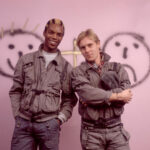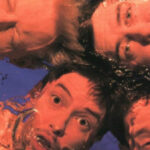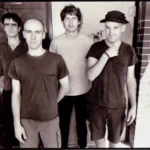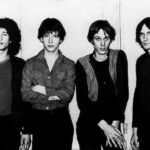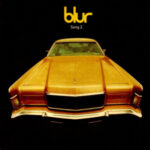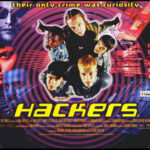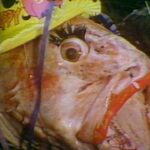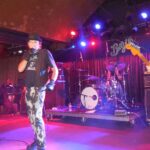 The Weirdos stand out as one of the earliest and most influential bands in the Los Angeles punk scene. Formed in 1976, they emerged during a period when punk was still a largely underground phenomenon in the United States, taking root in major cities like New York and London. Unlike many of their contemporaries, The Weirdos didn’t fit neatly into the angry, nihilistic mold often associated with punk music. Instead, they incorporated art, fashion, and a distinct sense of humor into their sound and image, making them both trailblazers and iconoclasts within the genre. Their music was raw, energetic, and rebellious, but it also bore the mark of a band that understood the power of visual expression and performance.
The Weirdos stand out as one of the earliest and most influential bands in the Los Angeles punk scene. Formed in 1976, they emerged during a period when punk was still a largely underground phenomenon in the United States, taking root in major cities like New York and London. Unlike many of their contemporaries, The Weirdos didn’t fit neatly into the angry, nihilistic mold often associated with punk music. Instead, they incorporated art, fashion, and a distinct sense of humor into their sound and image, making them both trailblazers and iconoclasts within the genre. Their music was raw, energetic, and rebellious, but it also bore the mark of a band that understood the power of visual expression and performance.
The Beginnings: Art Meets Punk
The Weirdos were founded by brothers John and Dix Denney, who were both art school dropouts and longtime collaborators. Born in Los Angeles, the Denney brothers were heavily influenced by the avant-garde art and music scenes of the 1970s. They had grown up steeped in the culture of early rock ‘n’ roll, surf music, and garage rock, and it was their love of these genres, combined with their fascination with visual art and performance, that shaped their approach to punk.
Unlike some punk bands, who were primarily interested in shock value or aggressive political messaging, The Weirdos approached the genre from an artistic standpoint. They were interested in aesthetics and performance as much as in sound, and this emphasis on visual presentation became one of their hallmarks. They viewed themselves as more than just musicians – they were performers and artists, and their shows were spectacles that combined music, fashion, and performance art in a way that set them apart from the rest of the L.A. punk scene.
The band’s name, The Weirdos, was a reflection of their attitude. They embraced their outsider status and reveled in being different from the mainstream. For the Denney brothers, being a “weirdo” wasn’t just about rejecting societal norms – it was about embracing individuality and creativity in a way that transcended conventional punk attitudes. This mindset would come to define the band’s approach to music and performance.
Early Performances and Sound
The Weirdos’ early performances were legendary for their chaotic energy and theatrical flair. In the early days of the Los Angeles punk scene, most venues were reluctant to book punk bands, as the genre was seen as too dangerous, unruly, or simply unmarketable. As a result, many of The Weirdos’ early shows took place in unconventional venues, such as art galleries, loft spaces, and even abandoned buildings. These performances were as much about creating an experience as they were about playing music, and the band quickly gained a reputation for their high-energy, unpredictable shows.
Their sound was heavily influenced by the raw, stripped-down rock of the 1960s, particularly bands like The Stooges and The Velvet Underground. However, The Weirdos added their own unique twist to this formula. Their music was fast and aggressive, but it was also infused with a sense of humor and irreverence that set them apart from some of the more nihilistic punk bands of the time. Songs like “Destroy All Music” and “Life of Crime” were not only aggressive punk anthems but also reflections of the band’s outsider mentality and their desire to disrupt conventional norms.
While The Weirdos were undoubtedly part of the early L.A. punk scene, their music was more eclectic than many of their contemporaries. They often incorporated elements of garage rock, surf music, and even glam rock into their songs, creating a sound that was both familiar and new. This eclecticism helped them stand out from the increasingly homogenous punk scene and gave them a broader appeal beyond the hardcore punk crowd.
The Visual Aesthetic: Fashion as Punk
One of the key aspects of The Weirdos’ identity was their emphasis on visual presentation. While punk fashion of the time often involved ripped clothing, leather jackets, and a general sense of disheveled rebellion, The Weirdos took a different approach. The Denney brothers were heavily influenced by art and fashion, and they used their image to make a statement. Their look was as much a part of their performance as their music.
The band’s stage attire often included brightly colored, mismatched clothing, bizarre accessories, and outlandish hairstyles. Their look was a deliberate contrast to the gritty, down-and-out aesthetic of many punk bands at the time. In doing so, they challenged the idea that punk had to look a certain way, and they showed that rebellion could be expressed through creativity and individuality, not just anger and aggression.
John Denney, in particular, became known for his flamboyant stage presence and fashion sense. His onstage persona was larger than life, and he often performed in outrageous costumes that made him look more like a cartoon character than a traditional rock frontman. This sense of theatricality became a defining feature of The Weirdos’ live shows and helped cement their status as one of the most distinctive bands in the L.A. punk scene.
Punk Rock Breaks Through
By the late 1970s, the Los Angeles punk scene was starting to gain national attention, and The Weirdos were at the forefront of this movement. Their eclectic sound, combined with their distinctive visual style, made them one of the most popular bands in the local punk scene. In 1977, they released their first EP, “Destroy All Music,” which became an underground hit and helped solidify their place in the punk pantheon.
The EP’s title track, “Destroy All Music,” became a punk anthem and encapsulated the band’s irreverent attitude. The song was a rallying cry for the punk movement, rejecting the bloated, commercialized rock music that dominated the airwaves and calling for something raw, real, and revolutionary. The lyrics, “Destroy all music, don’t make no sense,” perfectly captured the band’s ethos: they weren’t interested in making music that conformed to industry standards – they wanted to create something new, chaotic, and exciting.
Following the success of “Destroy All Music,” The Weirdos released a string of other influential recordings, including the “We Got the Neutron Bomb” single in 1978 and the “Who? What? When? Where? Why?” EP in 1979. These releases further solidified their reputation as one of the most innovative and exciting bands in the punk scene. While they never achieved the commercial success of some of their contemporaries, such as The Germs or X, The Weirdos were revered within the punk community for their originality and uncompromising vision.
The Struggles of Success
Despite their growing popularity, The Weirdos faced many of the same challenges that plagued other punk bands of the era. The L.A. punk scene was notorious for its internal conflicts, with bands frequently competing for limited resources and opportunities. Additionally, the lack of commercial support for punk music made it difficult for many bands to sustain themselves financially.
For The Weirdos, the struggle for success was compounded by their unwillingness to compromise their artistic vision. While some bands were willing to make concessions to attract mainstream attention, The Weirdos remained resolutely independent. This independence, while admirable, made it difficult for them to break through to a wider audience.
Moreover, the band’s eclectic sound and avant-garde image made them difficult to categorize. While they were often grouped in with the punk scene, their music didn’t always fit neatly into the punk genre. This made it harder for them to find a consistent audience, as they were often too punk for mainstream rock audiences but too experimental for hardcore punk fans.
By 1981, these challenges, combined with the toll of constant touring and the band’s internal tensions, led to The Weirdos disbanding for the first time. While they had left an indelible mark on the L.A. punk scene, the pressures of the industry and their refusal to compromise had ultimately taken their toll.
Legacy and Reunions
Although The Weirdos disbanded in the early 1980s, their influence on the punk scene continued to grow in the years that followed. Their eclectic sound, irreverent attitude, and emphasis on visual presentation paved the way for a new generation of punk and alternative bands that were willing to push the boundaries of the genre.
In the late 1980s and 1990s, The Weirdos experienced a resurgence of interest as punk rock underwent a revival, with bands like Green Day and The Offspring bringing punk-inspired music back to the mainstream. During this time, many fans and critics began to reappraise The Weirdos’ contributions to the genre, recognizing them as one of the foundational bands of the Los Angeles punk scene.
This renewed interest in The Weirdos led to several reunions, starting in the late 1980s. While the band’s lineup changed over the years, with various members coming and going, the core of John and Dix Denney remained. The Weirdos continued to play sporadically throughout the 1990s and 2000s, performing at festivals and special events. Though they never achieved the commercial success that some of their peers did, their influence on the punk scene remained undeniable.
In 2004, The Weirdos released “Weird World,” a compilation of their early recordings, including many tracks that had become cult favorites among punk fans. The compilation was well-received and helped introduce a new generation of listeners to the band’s music.
While The Weirdos have not been as active in recent years, their legacy continues to resonate within the punk community. Their willingness to experiment with sound and image, their commitment to individuality, and their refusal to conform to industry expectations have made them enduring icons of the punk movement.
Conclusion: The Weirdos’ Place in Punk History
The Weirdos may not have achieved the mainstream success of some of their contemporaries, but their impact on the Los Angeles punk scene and the broader punk movement is undeniable. They were pioneers who helped define the sound, style, and ethos of punk in Southern California, and their influence can be heard in countless bands that followed in their footsteps.
The Weirdos were more than just a punk band – they were artists, performers, and provocateurs who used music, fashion, and performance to challenge conventions and push boundaries. Their eclectic sound and irreverent attitude made them outsiders even within the punk community, but it was precisely this outsider status that allowed them to create something truly unique.
Today, The Weirdos are rightly regarded as one of the foundational bands of the Los Angeles punk scene, and their music continues to inspire new generations of musicians and fans. Their legacy is a testament to the power of individuality, creativity, and the enduring appeal of punk rock.
This post has already been read 327 times!
